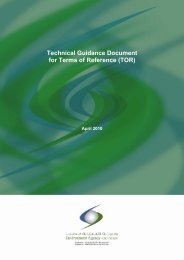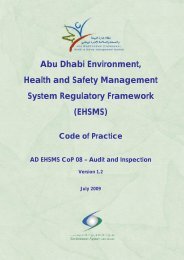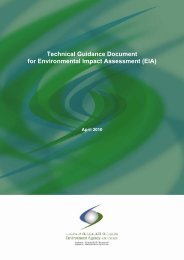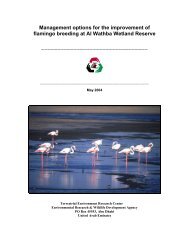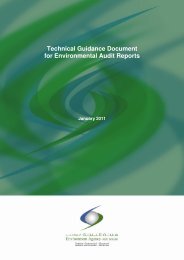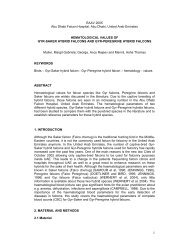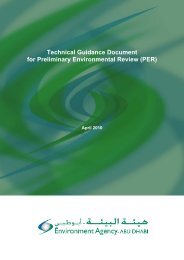Technical Guidance Document for Environmental Action Plan (EAP)
Technical Guidance Document for Environmental Action Plan (EAP)
Technical Guidance Document for Environmental Action Plan (EAP)
You also want an ePaper? Increase the reach of your titles
YUMPU automatically turns print PDFs into web optimized ePapers that Google loves.
<strong>Technical</strong> <strong>Guidance</strong> <strong>Document</strong> <strong>for</strong> <strong>Environmental</strong> <strong>Action</strong> <strong>Plan</strong><br />
technology is applied, EAD requires that the site/project provide a citation in the <strong>EAP</strong> of supporting,<br />
accepted international conventions or best practices.<br />
7.2 <strong>Environmental</strong> Monitoring<br />
The site/facility (or an EAD–approved EHS consultant on behalf of the site/facility) should submit a<br />
monitoring or sampling plan to EAD <strong>for</strong> approval. In addition, all environmental sampling and<br />
monitoring should be conducted, analysed, and reported by an EAD–approved EHS consultant. The<br />
sampling, analysis, and reporting, including appropriate quality assurance and quality control<br />
techniques, should meet minimum standards and requirements as published in current guidance by<br />
EAD, and Abu Dhabi EHSMS Regulatory Framework – Standards and Guideline Values should be<br />
referenced. Where not addressed by local guidance, these actions should be consistent with accepted<br />
international standards and practices.<br />
The <strong>EAP</strong> supporting documentation should provide the results of the sampling and monitoring and<br />
any evaluation of the results that led to the determination of the chosen corrective action(s). Where the<br />
<strong>EAP</strong> indicates that ongoing monitoring will be conducted, it should state the frequency, duration,<br />
parameters, and levels of readings or in<strong>for</strong>mation that would initiate further corrective action.<br />
7.3 Remediation of Contamination<br />
Existing contamination to soil, surface water, or groundwater that requires remediation activities<br />
should be evaluated to determine the methodology <strong>for</strong> remediation and disposal that provides the most<br />
effective resolution of the issue while being environmentally desirable and protective of human<br />
health, both on site and off site. Typically, remediation action involves some level of investigative<br />
sampling to determine the extent and level of contamination, followed by a feasibility study of<br />
available remedial, implementation, and disposal options. This process can be lengthy and complex,<br />
depending on the type and level of contamination. There<strong>for</strong>e, the <strong>EAP</strong> supporting documentation<br />
should provide EAD with enough detail as to the intended remediation action so that the<br />
determination can be made that all aspects have been addressed. Because the scope and complexity of<br />
these types of activities can vary widely, specific guidance will not be included here. The site/project<br />
is expected to confer with EAD and an approved EHS consultant on the appropriate level of ef<strong>for</strong>t and<br />
proceed accordingly.<br />
12





